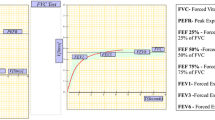Abstract
The identification of the asthmatic `case' in epidemiological research is a controversial issue. This study was aimed at classifying asthmatic subjects using a statistical decision rule that minimised the misclassification rate with respect to the clinicians' diagnosis. The rule was defined by a combination of predictors that are easily observed in epidemiological studies (asthma-like questions, physiological tests) without necessarily including the clinical opinion of expert physicians. From pooled data on 1103 subjects at the three Italian centres of the European Community Respiratory Health Survey (ECRHS) a post-consensus clinicians' diagnosis of asthma was obtained, and seven predictors were selected from among 18 potential candidates (specificity ranged from 64 to 99%, but sensitivity ranged from 22 to 62%). This data set was processed with tree-structured classifier techniques (the Classification And Regression Trees, CART), classical discriminant analysis (Fisher's Linear Discriminant Function, LDF), and the neural network method (Multi-Layer Perceptron, MLP model). The results suggest that modifications of the `classification tree' provide a more useful decision rule, sensitive (93%) and specific (85%), than either LDF or MLP. The decision tree is readily interpretable from a clinical perspective and uses five out of the seven predictors (in descending hierarchical order: ever had asthma, current asthma, shortness of breath, atopy and wheezing and breathless). The findings seem to indicate a considerable success with respect to previous epidemiological studies and await repetition in other ECHRS populations.
Similar content being viewed by others
References
Sears MR. Descriptive epidemiology of asthma. Lancet 1997; 350(2s): 1-4.
Ciba Foundation Guest Symposium. Terminology definition and classification of chronic pulmonary emphysema and related conditions. Thorax 1959; 14: 286-299.
American Thoracic Society. Definitions and classifications of chronic bronchitis, asthma and pulmonary emphysema. Am Rev Respir Dis 1962; 85: 762-768.
World Health Organisation. Epidemiology of chronic non-specific respiratory diseases. Bull WHO 1975; 52: 251-259.
Gross NJ. What is this thing called love?—Or, defining asthma (editorial). Am Rew Respir Dis 1980; 121: 203-204.
Toelle BG, Peat JK, Salome CM, Mellis CM, Woolcock AJ. Toward a definition of asthma for epidemiology. Am Rev Respir Dis 1992; 146: 633-637.
Global strategy for asthma management and prevention — NHLBI/WHO Workshop report (March 1993). Bethesda: National Institute of Health, National Heart Lung and Blood Institute. Publication No 95-3659, 1995.
Burr ML. Diagnosing asthma by questionnaire in epidemiological surveys (editorial). Allergy 1992; 22: 509-510.
Cerveri I, de Marco R, Bugiani M, et al. Can clinical judgement be a gold standard for identifying bronchial asthma in epidemiological studies? Interobserver agreement and contribution of specific diagnostic procedures. Monoldi Arch Chest Dis 1998 (submitted).
Lilienfeld AM, Kordan B. A study in the interpretation of chest X rays in the diagnosis of lung-cancer. Cancer Res 1966; 26: 2145-2147.
Feinsten AR, Geilfman NA, Yesner R, Auerbach O, Hackel DB, Pratt CB. Observer variability in histopathologic diagnosis of lung cancer. Am Rev Respir Dis 1970; 101: 671-684.
Jenkis MA, Clarke JR, Carlin JB, et al. Validation of questionnaire and bronchial hyperresponsiveness against respiratory physician assessment in diagnosis of asthma. Int J Epidemiol 1996, 25(3): 609-616.
Burney PGJ, Luczynska C, Chinn S, Jarvis D, for the European Community Respiratory Health Survey. The European Community Respiratory Health Survey. Eur Respir J 1994; 7: 954-960.
The European Community Respiratory Health Survey. 'Medicine and Health', European Commission, Directorate-General XIII, Office for Official Publications, L-2920 Luxembourg, 1994.
De Marco R, Verlato G, Zanolin E, Bugiani M, Drane JW. Nonresponse bias in EC Respiratory Health Survey in Italy. Eur Respir J 1994; 7: 2139-2145.
European Community Respiratory Health Survey — Italy. Prevalence of asthma and asthma symptoms in a general population sample from northern Italy. Allergy 1995; 50: 755-759.
Verlato G, Cerveri I, Villani A, et al. Evaluation of methacholine dose-response curves by linear and exponential mathematical models: Goodness-of-fit and validity of extrapolation. Eur Respir J 1996; 9: 506-511.
Cerveri I, Zoia MC, Bugiani M, et al. Inadequate antiasthma drug use in the north of Italy. Eur Respir J 1997; 10: 2761-2765.
De Marco R, Cerveri I, Bugiani M, Ferrari M, Verlato G. An undetected burden of asthma in Italy: The relationship between clinical and epidemiological diagnosis of asthma. Eur Respir J 1998; 11: 599-605.
Pepys J. Atopy: A study in definition (editorial). Allergy 1994; 49: 397-399.
American Thoracic Society. Evaluation of impairment/disability secondary to respiratory disorders. Am Rev Respir Dis 1986; 133(6): 1205-1209.
Hand DJ. Construction and Assessment of Classification Rules. New York (US): Wiley, 1997.
Morineau A. Introduction à SPAD, Version 3.01. Saint-Mandé (France): CISIA, 1996.
Burney PGJ, Chinn S, Britton JR, Tatterfield AE, Papacosta AO. What symptoms predict the bronchial response to histamine? Evaluation in community survey of the bronchial symptoms questionnaire (1984) of the International Union Against Tuberculosis and Lung Disease. Int J Epidemiol 1989; 18(1): 165-173.
Bruschi C, Cerveri I, Zoia MC, Maccarini L, Grassi M, Rampulla C. Bronchial responsiveness to inhaled methacoline in epidemiological studies: Comparison of different indices. Eur Respir J 1989; 2: 630-636.
Efron B, Tibshirani RJ. An Introduction to the Bootstrap. New York: Chapman & Hall, 1993.
Hand DJ. Screening vs prevalence estimation. Appl Statist 1987; 36: 1-7.
Armitage P, Berry G. Statistical Methods in Medical Research. Oxford: Blackwell Scientific, 1994.
Author information
Authors and Affiliations
Rights and permissions
About this article
Cite this article
Grassi, M., Villani, S. & Marinoni, A. Classification methods for the identification of `case' in epidemiological diagnosis of asthma. Eur J Epidemiol 17, 19–29 (2001). https://doi.org/10.1023/A:1010987521885
Issue Date:
DOI: https://doi.org/10.1023/A:1010987521885




